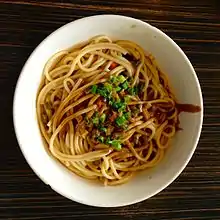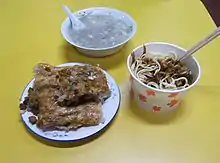Hot dry noodles
Hot dry noodles (simplified Chinese: 热干面; traditional Chinese: 熱乾麵; pinyin: règānmiàn), also known as reganmian, is a traditional dish of Wuhan, the capital of Hubei province in central China.[1] Hot dry noodles have an 80-year history in Chinese food culture; they are unique because the noodles are not in a broth like most other Asian-style hot noodle dishes.[2] They are the most significant, famous and popular breakfast food in Wuhan, often sold by street carts and restaurants in residential and business areas.[3] Breakfasts such as hot dry noodles are available from about 5 am, and usually appear at Wuhan's night markets as a late-night snack. These noodles can be prepared within minutes and are affordable, so they are a popular breakfast. There are hot dry noodle restaurants all over the city.
 | |
| Alternative names | 热干面 |
|---|---|
| Type | Noodles |
| Course | Breakfast |
| Place of origin | China |
| Region or state | Wuhan |
| Main ingredients | Alkaline noodles, soy sauce, sesame paste, pickled carrots, garlic, chili oil |

Typical hot dry noodle dishes contain soy sauce, sesame paste, pickled vegetables (carrots and beans), chopped garlic chives and chili oil.[4] Hot dry noodles, along with Shanxi's knife-cut noodles (刀削面; 刀削麵; dāoxiāomiàn), Liangguang's yifumian, Sichuan's dandanmian, and northern China's zhajiangmian, are collectively referred to as the "Top five noodles of China" by People's Daily, and in a 2013 article titled "China's Top 10 famous noodles" Business Insider reported that CNTV rated reganmian the top Chinese noodle dish.[5][6] In 2011, the making technique of Cai Linji Hot-dry noodles was listed into the Intangible Cultural Heritage List of Hubei Province.Quoted from this page:Hot-dry Noodles in Hubu Alley, Wuhan City, Hubei ProvinceFrom the above, we can know that Hot-dry Noodles is not only one typical food, also one important Chinese culture.The specifics of the preparation of hot dry noodles is discussed in Wuhan author Chi Li's novel '热也好冷也好活着就好'. Fighting hot dry noodles presents a slogan during Coronavirus.
Cooking method
The recipe for hot dry noodles is different from cold noodles and noodles in soup.
Both Wuhan and Szechuan cuisine make extensive use of chilis to cleanse the palate and cope with the humid climate.[7] The fresh noodles mixed with sesame oil are cooked in boiling water. The cooked and cooled noodles become pliable. Before eating, the noodles will be cooked again the same way, and dressings including spring onion and sauce are added.[8] While preparing hot dry noodles, the noodles are placed into a cone-shaped Chinese strainer, dipped briefly into boiling water, and then swirled and drained. The noodles are poured into a paper bowl, and the sauce and pickled vegetables are poured on top. Chili oil and a little fresh coriander is usually used in the seasoning of hot dry noodles.
Origin
Summer in Wuhan is extremely long, and the high temperature causes food to deteriorate rapidly. Consequently, in the past people added dietary alkali into noodles to slow deterioration; this evolved into hot dry noodles.
According to a widely circulated rumor, in the early 1930s there was a small food stand operated by Bao Li, a hawker who made a living by selling bean noodles and noodle soups near a temple in Hankou. One day, Li poured sesame oil onto his noodles accidentally; he boiled them and added shallot and other condiments the next day, and sold them the next morning. His noodles became very popular because of their unique taste, and customers asked Bao Li what kind of noodle it was; Bao Li answered "hot dry noodles".[9][10]
Variety
During the development and spread of the technique of making hot dry noodles, people in Xinyang, a city in Henan Province, developed their own special way to make them, which became a variant of hot dry noodles eventually.[11][12]
See also
References
- OotTheMonk. (2012, Feb 20). [Web log message]. Retrieved from http://www.instructables.com/id/Hot-and-Dry-Noodles-Re-Gan-Mian-/
- Hubei Tourism Bureau. (2012, 04 21). Hot dry noodles . Retrieved from "Archived copy". Archived from the original on 2012-07-22. Retrieved 2012-11-22.CS1 maint: archived copy as title (link)
- Yu , J. F. (2006, 10 13). [Web log message]. Retrieved from http://wuhanstories.blogspot.ca/2006/10/needless-to-say-hot-dry-noodle-is-most.html
- Hot dry noodles. (2004, 09 03). Retrieved from http://www.cnhubei.com/200408/ca554353.htm
- ""中国十大面条"出炉热干面居首 你吃过几样". 人民网. Archived from the original on 2014-01-17. Retrieved 2013-07-09.
- "IT'S OFFICIAL: Here Are The Top 10 Kinds Of Chinese Noodles". Business Insider. Retrieved July 9, 2013.
- Parkinson, R. (2012). Hot in Hunan. Retrieved from http://chinesefood.about.com/od/regionalchinesecuisine/p/hunan.htm
- Xu, X. (2008). Re gan mian (hot-dry noodles). Retrieved from "Archived copy". Archived from the original on 2012-11-13. Retrieved 2012-11-23.CS1 maint: archived copy as title (link)
- Anderson, E. N. (1990/09/10). The food of china. (1st ed.). Yale University Press. Retrieved from "Archived copy". Archived from the original on 2012-12-12. Retrieved 2012-11-22.CS1 maint: archived copy as title (link)
- 湘水散人. (2009, 09 03). Hot dry noodles [Online forum comment]. Retrieved from http://www.3us.com/thread-3991-1-1.html
- "信阳热干面". 新浪网. Retrieved March 3, 2015.
- "武汉热干面怎么做的,和信阳热干面有什么不同? - 知乎用户的回答 - 知乎". Zhihu. Dec 17, 2014. Retrieved Apr 2, 2018.
